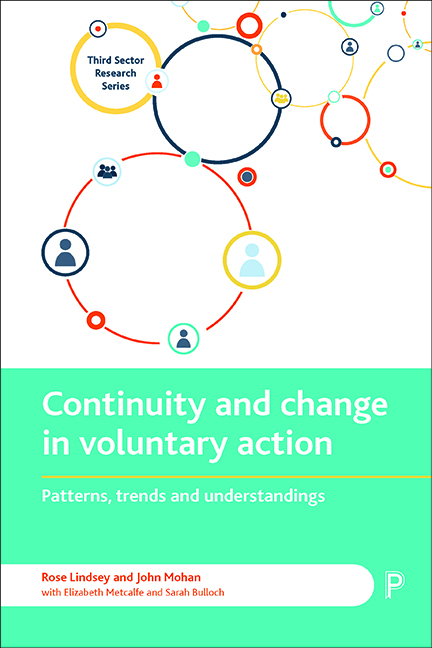Book contents
- Frontmatter
- Contents
- List of figures and tables
- Foreword
- Acknowledgements
- Notes on authors
- Acronyms
- one Introduction
- two The changing policy environment for voluntary action from 1979
- three Data: sources and definitions
- four Trends in volunteering and trends in the voluntary sector
- five Content and context of volunteering
- six Why people volunteer: contextualising motivation
- seven Volunteering trajectories: individual patterns of volunteering over the lifecourse
- eight Attitudes to voluntary action
- nine Conclusions
- Appendix: Anonymised details of writers
- References
- Index
seven - Volunteering trajectories: individual patterns of volunteering over the lifecourse
Published online by Cambridge University Press: 13 April 2022
- Frontmatter
- Contents
- List of figures and tables
- Foreword
- Acknowledgements
- Notes on authors
- Acronyms
- one Introduction
- two The changing policy environment for voluntary action from 1979
- three Data: sources and definitions
- four Trends in volunteering and trends in the voluntary sector
- five Content and context of volunteering
- six Why people volunteer: contextualising motivation
- seven Volunteering trajectories: individual patterns of volunteering over the lifecourse
- eight Attitudes to voluntary action
- nine Conclusions
- Appendix: Anonymised details of writers
- References
- Index
Summary
Introduction
When recent British governments have attempted to promote volunteering, there has been a tendency to issue general exhortations, focus on specific groups believed to be underrepresented, or target attention on disadvantaged areas, rather than focusing on how and when people volunteer (Chapter Two). In this chapter, which considers volunteering behaviour over time, we argue for a deeper understanding of the volunteering trajectories taken by individuals across their lifecourse, relating these to individual and household characteristics, and key trigger points in the lives of the respondents. The insights from this may be of value to those who seek to increase levels of voluntary action.
Using longitudinal approaches may also provide a different perspective on underlying rates of engagement in voluntary action. Analyses of volunteering often use cross-sectional surveys – snapshots of evidence at specific points in time. Survey participants are identified as having volunteered if they answer affirmatively to a question usually framed within a reference period (4 weeks, 12 months). However, someone who has volunteered extensively outside of the given timeframe might not be identified as a volunteer. This has led analysts of some cross-sectional surveys, such as Low et al (2007), to identify those who have taken part in volunteering in the past, but not in the previous 12 months and to describe these participants as ‘ex-volunteers’ (pp 11–12). Are they truly ‘ex’-volunteers – people who no longer volunteer? Or are they simply people who happen not to have done any voluntary activity in the 12-month reference period? If these people were surveyed repeatedly over a long timeframe then we would identify many people who, while not volunteering every year, do so from time to time. The ‘true’ rate of volunteering may thus be higher than is suggested by cross-sectional surveys. To answer these questions we need longitudinal understandings of patterns of volunteering across individual lifecourses (Musick and Wilson, 2008, 221–3).
There has been no single longitudinal quantitative study of patterns of volunteering that is representative of the UK population across the whole of 1981 to 2012 timeframe. The British Household Panel Survey (BHPS) began in 1991 and first asked about ‘unpaid voluntary work’ in 1996; the survey questions were carried forward into the significantly-expanded Understanding Society (US) survey from 2011.
- Type
- Chapter
- Information
- Continuity and Change in Voluntary ActionPatterns, Trends and Understandings, pp. 153 - 182Publisher: Bristol University PressPrint publication year: 2018



